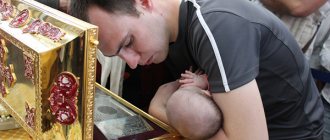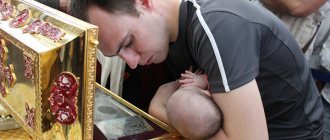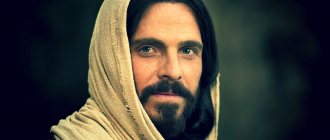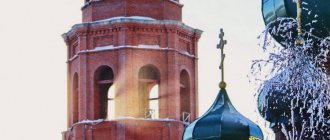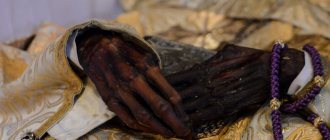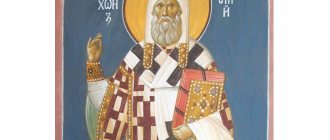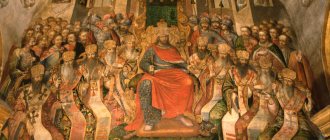There is probably not a single person, especially among the Russian-speaking population, who has not heard this phrase.
Perhaps someone has their own idea about this, while others have no idea at all. But I would really like to know exactly and in detail - what is it? To understand this, you will need to look into history , and not just as an era, but into the history of the church. A look into those times when people had deep faith in God and, thanks to faith, accomplished amazing things.
Relics of saints, what are they?
So, what does the word “power” mean? It's very simple - these are the remains of a deceased person. But why “power”? After all, this word refers to the meaning of enormous power. But this is exactly what was said, that those people of deep faith performed unusual deeds , feats and even supernatural miracles, as if there was a great power behind them.
And therefore, after death, their bodies could hardly be called simply remains, but were called the relics of saints. Moreover, people believed, and still believe today, that the incredible power that accompanied them during life remained and is present in the remains! Now we can give a precise definition - these are the remains of holy people who can perform unusual actions. In the history of the church and today you can hear many testimonies of such miracles near the relics!
Christian priests explain this phenomenon by the fact that saints and righteous people not only have a holy soul, but also a body. Therefore, they are not only venerated as a memory, but their remains are also venerated and preserved, considering them a source of Divine grace to which one can turn in prayer.
A little theology
The most difficult question is what veneration of relics means for Christians. As far as one can judge, neither the ancient tradition nor the Old Testament knew a similar Christian cult of veneration of the graves and remains of the dead. Moreover, pre-Christian religious history knows many examples of treating the bodies of the dead and remains as unclean, defilement, which required religious rituals of purification of those who in one way or another came into contact with the dead.
Faith in Christ the Savior and the Christian view of man introduced an exception to the general picture of the ancient world. The New Testament is filled with hope for healing from death; at one time this was even reflected in the fact that the color of mourning for Christians was white - the color of purity and joy. The bodies of the dead can only be treated with respect, reverence and veneration. Otherwise it can not be. Christians believe that God in Christ became a man, not a ghost or “inhabiting” someone for a while (like various spirits from horror films). Jesus was born of the Virgin Mary and grew up like each of us. According to the testimonies of His friends and disciples reflected in the Gospels, Christ lived among people for more than thirty years, preached among the people of Israel for the last three years, announcing the coming of the Messiah-Savior, taught His followers to live by faith in God, cared for many people, healed and consoled their. According to his own prophecy, Jesus was arrested, beaten, and crucified on the cross. After which he died and was resurrected on the third day.
Jesus Christ cannot be imagined outside of His own human body. The same goes for every person. Every body, even a dead one, remains a creation of God, and even if it is distorted by death, the Lord will not allow it to remain in this state forever. Christians are confident that He will restore and resurrect everyone in the glory that He intended for man from the creation of the world.
No matter how you look at what has been said, there were and are not similar testimonies about someone else, the same teaching as the gospel offers. It’s all about the attitude towards a person, who is only a person when he is whole, when he can manifest himself in the trinity of spirit, soul and body. For Christians, the body is not a shell, but an integral opportunity to express oneself in this world, to express oneself in relation to other people.
A person is a complex being; without a body he is not a person. To be human according to God's design is to be human forever. To be born once means to enter into existence forever. Christ by His resurrection showed that only in integrity can one enter heaven to the Heavenly Father. This means that the body of the deceased is something very dear and mysterious, it is something that is just as involved in God as the soul and spirit.
I wonder what definition Wikipedia gives?
Material from Wikipedia - the free encyclopedia:
Relics (ancient Greek λείψανα, lat. reliquiae) are the remains of people canonized after death. The relics of saints are objects of veneration in Historic churches. The doctrine of their obligatory veneration was confirmed in 787 at the Second Nicene (Seventh Ecumenical) Council. According to this teaching, relics are carriers of grace and must be preserved and venerated for moral, edifying and liturgical purposes.
This definition confirms what was written above and provides complete understanding.
What kind of holy relics do they look like?
The main thing is to understand that they can look different. This is not necessarily a whole body or incorruptible, because such a word can often be heard. But in the history of the church, saints were burned for their faith, thrown to lions, tortured, sawed up. You can even read about this in the Bible, for example, Hebrews, chapter 11. Therefore, the type of relics can be bones, body parts, ashes, that is, different remains. But there are also incorruptible relics , for example, of Sergius of Radonezh. But the most important thing is not what the remains look like, but the main thing is that they are accompanied by miracles, only such ones are called saints.
No. 10. Luka (Voino-Yasenetsky)
Another controversial figure in modern Orthodoxy is St. Luke of Crimea, a bishop of the Russian Orthodox Church who taught medicine, worked as a surgeon, and received the Stalin Prize of the first degree. The award did not help the doctor-clergyman - he was sent into exile for 11 years. In 1995, Luke was canonized by the Ukrainian Orthodox Church, and five years later by the Russian Church.
|
They pray to Saint Luke for healing from physical ailments, for a successful birth, and ask for blessings for a surgical operation. The relics of St. Luke were welcomed in Yekaterinburg in 2021. In addition, the city has a temple consecrated in honor of this saint.
Where and how are the relics of saints kept?
Because the remains have such miraculous properties, they are not buried.
the remains of a righteous person are found somewhere , they are transferred to the temple. At the same time, a whole ritual is performed and this is called “finding the relics.” Then they are placed in a box called “raka”.
Sometimes the relics are displayed, especially on major religious holidays, so that people can honor them. In this case, a special box is made from expensive trees and precious metals, shaped like a coffin. It is decorated with beautiful fabrics. The relics should be in every Orthodox church. Since worship can only be held where there is power. This was introduced in the seventh century. It is as if the service is taking place in the presence of saints . To do this, the relics can be divided into particles so that there is enough for all places of worship. People believe that no matter whether it is a whole part or a particle, divine power and grace are equally present there.
Why don't the relics of saints smolder?
From history you can read many cases when the bodies of the deceased were found incorrupt, but in fact, most often these are legends, beliefs, and all this is of a manipulative nature.
It is for this reason that the church decided not to consider incorruption a sign of holiness, but only miracles. But still, there are facts of such cases. Scientists explain this in different ways. Sometimes this happened due to a special burial place, for example, the basements of the catacombs and due to natural conditions, the bodies were actually preserved. But there are also many cases where scientists were perplexed and were forced to admit the peculiarity of the remains of saints. In comparison with the Egyptian mummies, which were fetid, the remains of the saints, on the contrary, were fragrant, and scientists found that this was not related to embalming, especially since the Orthodox Church did not allow embalming. And it was associated with a change in the structure of the body. They also say that every saint smells uniquely!
Of course, Orthodox believers have always believed and will continue to believe that there is, after all, divine intervention. In Orthodox theology, this is described as a sign of the future resurrection of bodies promised to believers.
Another very interesting fact about the Athonite monks. In their faith and tradition, everything was just the opposite. When they buried their brothers , after that they began to pray for them . Then, after a while, they dug up the corpse and checked it. If the body did not decay, this was considered a sign of sin, they buried it again and continued to pray even more for the deceased brother. Then they checked again and so on.
No. 6. Silouan of Athos
Silouan Afonsky (in secular life - Semyon Antonov) was born in the Tambov region in the middle of the 19th century. After serving in the engineer battalion, he went to Mount Athos and entered the Russian Panteleimon Monastery. He struggled with temptation all his life and died at the age of 72. He was canonized in the 80s. XX century. The head of the venerable husband is kept on the island of Athos, sometimes it is taken out along with the relics.
|
In mid-2021, the relics of Silouan were brought to Yekaterinburg. They were met by clergy of the Yekaterinburg diocese and the head of the region, Evgeny Kuyvashev. Metropolitan Kirill of Yekaterinburg and Verkhoturye advised believers to ask Silouan of Athos not for healing from ailments, but for strong faith.
One of the most revered Orthodox saints
Saint Matrona, or as they prefer to call her, Matronushka . She was a poor peasant woman , also blind, but very deeply religious.
When she turned to the Lord, many miracles of healing occurred through her prayer. Even during her lifetime, crowds of people flocked to her. She also showed the gift of prediction. Matrona spent most of her life sitting. Even when she was sick, she did not stop accepting people until her death.
- Today, the remains of Matrona are kept in the Moscow Orthodox monastery. Because of this, the territory of the monastery is never empty. People constantly come from all parts of the country, creating long queues. They want to touch Saint Matrona and ask her for her many needs.
- Visiting pilgrims is allowed at certain times: from six in the morning until eight in the evening.
- People know and believe that Matrona will help. People turn to her for intercession, solving problems with health, in business, in personal life, in infertility . They also ask when something is missing and needs to be found.
- People are taught how to pray correctly. You need to start with certain words: “Oh, blessed mother Matrona” or “Holy righteous old woman Matrona, ask God for us”
- You also need to know how to kiss Matrona’s body. To express their respect to her, they first take off their outer clothing and leave their things and bags behind. Then you need to calm down and concentrate on prayer, then cross yourself twice, bow the same amount, and now they apply their lips to the shrine. After this, you need to be baptized again and bow. You need to bow low until your hand touches the ground.
- People carry fresh bouquets of flowers in large numbers, so the area around the crayfish is always buried in flowers. These flowers are not thrown away, but are distributed to people one at a time, the rest are dried and stored. You can bring roses, carnations, any flowers, but lilacs and chrysanthemums, only white ones and you can also bring red tulips.
- Many people talk about their experiences that when they approach Matrona and pray, they immediately feel whether there is an answer or not. Peace comes to your soul, which means the request is accepted, or you feel rejected, which means it’s not. But everyone knows and believes that Matrona wants to help everyone. And if a negative feeling arises, you need to think that maybe the request is not a need. Maybe this request is sinful or out of spite.
- During her lifetime, Matrona taught: “You need to trust God’s will, the Lord will arrange everything!”
No. 4. St. George the Victorious
The Great Martyr George is known to Russians because he is depicted on the country's coat of arms. The famous scene of killing a snake with a spear is described in the life of the saint. According to legend, the snake was worshiped as a deity by the inhabitants of the pagan city. They sacrificed their children so that the monster would not attack the settlement. After George dealt with the snake in front of the residents, they converted to Christianity.
George died young when Emperor Diocletian began persecuting Christians. After a public confession of faith, the 23-year-old warrior was captured, tortured for a week, forced to renounce, and then beheaded.
In Russia, George is considered the patron saint of cattle breeding and a protector from predatory animals, and he also heals snake bites. As a warrior, he helps military personnel, they pray to him to grant victory over enemies.
|
The hand (right hand) of St. George is kept in the Xenophon monastery on Athos. It was brought to Russia during the celebration of the 70th anniversary of the Great Victory over fascism.
What significance does the veneration of holy relics give to people?
- Moral significance and influence on the souls of living people, as it reminds of the personality of the righteous, his faith, and behavior. This encourages people to follow their example and do the same things and feats. An awakening comes in people's minds, especially remembering the great martyrs, encouraging people to righteousness.
- Significance for worship, making it special, as it reminds that both the living and the dead are one in one Church. That earthly life is not the end. You can look at Orthodox cemeteries and see that the graves still look like thrones in churches. Because earlier, where there were no churches, believers could hold services directly at the graves of dead saints.
- Of course, the practical significance is miracles . Even in the most hopeless situation , a person has hope for a miracle, through the imperishable source of strength in the holy remains!
